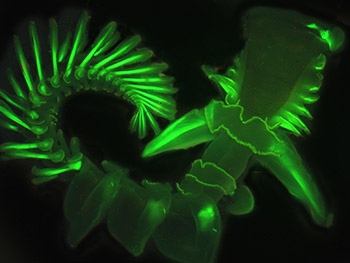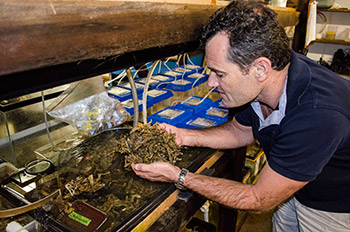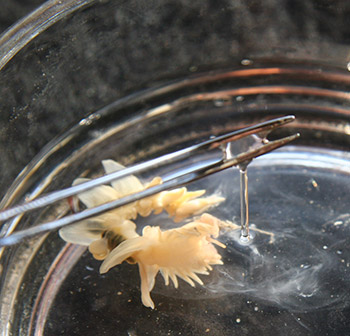Nature’s Glowing Slime: Scientists Peek into Hidden Sea Worm’s Light
Clouds of bioluminescent mucus—emitted by a marine worm that lives in a cocoon-like habitat —is linked to a common vitamin
By:
- Mario Aguilera
Published Date
By:
- Mario Aguilera
Share This:
Article Content
Scientists at Scripps Institution of Oceanography at UC San Diego and their colleagues are unraveling the mechanisms behind a little-known marine worm that produces a dazzling bioluminescent display in the form of puffs of blue light released into seawater.
Found around the world in muddy environments, from shallow bays to deeper canyons, the light produced by the Chaetopterus marine worm—commonly known as the “parchment tube worm” due to the opaque, cocoon-like cylinders where it makes its home—is secreted as a slimy bioluminescent mucus.

A full-body fluorescence image of the parchment tube worm.
The mucus, which the worms are able to secrete out of any part of their body, hasn’t been studied by scientists in more than 50 years. But two recent studies have helped reignite the quest to decode the inner workings of the worm’s bioluminescence.
In one study, published in the journal Physiological and Biochemical Zoology, Scripps Associate Research Scientist Dimitri Deheyn and his colleagues at Georgetown University describe details of Chaetopterus’s light production as never before. Through data derived from experiments conducted inside Scripps Oceanography’s Experimental Aquarium, the researchers characterized specific features of the worm’s light, tracing back its generation to a specific “photoprotein” tied to bioluminescence.
“The fact that the light is produced as a long glow without direct oxygen consumption is attractive for a range of future biotechnological applications,” added Deheyn, whose current work focuses on identifying the specific protein(s) involved in the light production.
The present study, however, focused on the general biochemistry and optical properties of the light production. “We have shown that the mucus produces a long-lasting glow of blue light, which is unique for this environment where bioluminescence is usually produced as short-lived flashes of light in the green spectrum, especially for benthic (seafloor) species,” said Deheyn, who added that green travels farthest and is therefore the easiest to detect in shallow coastal environments.

Dimitri Deheyn
As for the light’s ecological function, the researchers speculate that the luminous mucus may serve as a trap to attract prey, a deterrent to ward off certain unwelcome guests into the worm’s living areas (the glowing mucus could stick to an intruder, making it more visible to its own predators), or possibly serve as a substance to build the worms’ flaky, tube-shaped homes.
The blue color makes it intriguing and difficult to reconcile with a visual function for shallow animals only.
“However, one can imagine that blue light would work better if the predator is a fish coming from greater depths, or for specific predators for which we still don’t know the visual sensitivity,” concluded Deheyn.
In a separate study, Deheyn and his colleagues at Connecticut College found that riboflavin, known as vitamin B2 and used widely as a dietary supplement, is a key source of the light production. The study appearing in Photochemistry and Photobiology focused on worms collected by Scripps Marine Collector and Technician Phil Zerofski in the La Jolla submarine canyon off the coast of San Diego, California. The research revealed riboflavin as the major fluorescent compound in all extracts of the worm’s luminescent material, including the glowing slime. Although more investigation is needed, the authors hypothesize that a derivative of riboflavin serves as the emitting force in the worm’s light-production process.

Parchment tube worm
The authors note that the worms are not able to produce riboflavin on their own—only plants and microbes can—therefore the worms must acquire the vitamin through a food source, the same way humans do.
“We have shown that the bioluminescent light production involves riboflavin, which is key because it means that the worm is relying on an external source,” said Deheyn. “We suggest the light production depends on the worm’s diet, yet it could also involve a symbiosis with bacteria (possibly living in the tube) to provide the riboflavin.”
Further investigations are targeting intricacies of the chemical reactions behind the light production and methods to synthesize the light production in the laboratory.
The Air Force Office of Scientific Research’s Natural Materials, Systems, and Extremophiles Program and the Hans & Ella McCollum ’21 Vahlteich Endowment supported the research.
Share This:
Stay in the Know
Keep up with all the latest from UC San Diego. Subscribe to the newsletter today.



